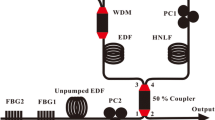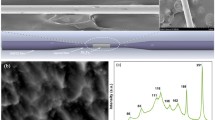Abstract
We propose and demonstrate a multiwavelength erbium-doped fiber laser stabilized by four-wave mixing (FWM) in a nonlinear silicon-on-insulator (SOI) waveguide. The optical gain was provided by an erbium-doped fiber amplifier, and the wavelength selectivity was achieved by a Fabry–Pérot comb filter in the ring cavity. The FWM in the SOI waveguide was enhanced by applying a reverse-biased p-i-n diode structure to reduce free-carrier absorption. Making use of the nonlinearity of the SOI waveguide, a multiwavelength laser with six output wavelengths at 0.8 nm spacing was achieved. The power difference among modes was equalized within a range of 1.8 dB. The power fluctuation of each mode was stabilized to <0.65 dB during 20 min observation at room temperature.
Similar content being viewed by others
Avoid common mistakes on your manuscript.
1 Introduction
Silicon photonic integrated devices have attracted a considerable interest in bio-sensing, gas detection, and spectroscopy because of their potential for lab-on-a-chip applications with a number of advantages, such as low-cost, high-sensitivity, small-size, and high-scale integration. A number of highly compact silicon optical sensors based on Mach–Zehnder interferometers, microresonators, and photonic crystals have been proposed and demonstrated [1–6]. Recently, wavelength division multiplexing (WDM) sensing schemes have been investigated, which provide a more simpler, lower cost, and higher speed solution compared with single wavelength approach [6, 7]. However, the bulkiness and cost of conventional WDM light sources are proportional to the number of wavelengths.
Multiwavelength erbium-doped fiber lasers (EDFLs) provide compact and low-cost multiwavelength sources [7]. However, the homogeneous gain broadening of erbium-doped fibers (EDFs) leads to the laser instability because of gain competition [8, 9]. There are several different approaches that have been previously proposed to suppress these instabilities [7, 10–15]. Among these techniques, FWM provides a simple and flexible method for laser cavity design. It has been successfully demonstrated in dispersion shifted fibers (DSFs), highly nonlinear fibers (HNLFs), photonic crystal fibers (PCFs), and graphene [11–15].
Moreover, for silicon optical sensor platform, the nonlinear media can be directly replaced by nonlinear silicon-on-insulator (SOI) waveguides which have been used in high-speed nonlinear all-optical signal processing [16]. It is due to the high Kerr nonlinearity, n 2, of bulk silicon which is over 2 orders of magnitude larger than that of silica. Together with smaller effective area in SOI waveguides, the resulting nonlinear optical coefficient (γ) is typically of the order of 100 W−1m−1 [16, 17], which is about four orders of magnitude larger than commercial HNLF and PCF which have γ of about 0.01 W−1m−1. Thus, a centimeter length of SOI waveguide may replace an HNLF or PCF with hundreds of meters length. It is also possible to simplify the laser cavity by integrating a number of optical components onto a single chip, which decreases the cost and complexity of the system. Furthermore, employing SOI waveguide in the multiwavelength EDFL greatly reduces the fiber laser cavity length and potentially improves the laser stability. By embedding part of the laser cavity into the silicon chip, the laser output can be directly used in the integrated sensor components and high-speed feedback control of the cavity becomes possible. In this paper, we propose and demonstrate the stabilization of a multiwavelength EDFL which uses FWM in a SOI waveguide to stabilize simultaneous lasing at different wavelengths.
2 Experimental setup
The experimental setup is shown in Fig. 1. An erbium-doped fiber amplifier (EDFA) having a maximum saturated power of 28 dBm was operated as the gain medium. An optical isolator ensured unidirectional operation of the ring cavity. The SOI waveguide of 15 mm length was inserted after the output 10/90 optical coupler (OC) and the polarization controller (PC) following the EDFA in order to ensure reasonable optical power in the silicon for triggering FWM which stabilizes and equalizes optical power between each wavelength. The light was coupled between the SOI waveguide and standard single mode fibers (SMFs) through grating couplers, which are widely used in silicon optical sensor systems [2, 4–6, 18]. The grating couplers also work as tunable broad bandpass filters and polarizers inside the cavity [18]. The lasing wavelengths were selected by a Fabry–Pérot (F–P) comb filter with 0.8 nm wavelength spacing. Only the cavity modes coinciding with the comb filter resonances will be able to lase, and the other cavity modes are suppressed.
The SOI waveguide and the grating couplers were fabricated on the SOI wafer with 220 nm top silicon layer and 2 μm buried oxide (BOX). To reduce free-carrier absorption (FCA) generated by two-photon absorption (TPA) in high-power regime, a rib waveguide structure with a reverse-biased p-i-n diode was applied [19]. The waveguide width is 500 nm in order to satisfy the single mode condition of quasi-transverse electric (TE) mode at 1.55 μm. The calculated mode field profile is shown in Fig. 2a, which has a mode effective area and theoretical γ of 0.17 μm2 and 59 W−1m−1 [17], respectively.
The grating couplers are designed for coupling quasi-TE light between the SOI waveguide and standard SMF with 9 μm core diameter at 10° off-vertical orientation, as shown in Fig. 1b. The wavelength of the maximum coupling efficiency can be changed by detuning the incident angle of the fiber. It can be achieved by fine adjustment of the position of the fiber relative to the grating coupler. The total transmission spectra of input/output grating couplers and the 15 mm silicon waveguide with different fiber positions are shown in Fig. 2b. A total insertion loss of ~15 dB at 1,560 nm is observed for two grating couplers and 15 mm length of SOI length waveguide. Thus, the total cavity loss is ~18 dB, including the OC and F–P filter which has a peak insertion loss of 2.6 dB. The insertion loss of the SOI chip can be potentially reduced to ~4.7 dB using the apodized grating couplers with 1.2 dB loss and waveguides with losses of about 1.5 dB cm−1 [20, 21]. Defining the fiber position with maximum coupling efficiency centered around 1,560 nm as position x o, the center wavelength can be fine-tuned around ±5 nm by detuning the fiber position with ±2.5 μm along x′-axis shown in Fig. 1b. The grating couplers serve two roles: as tunable broad bandpass filters and as linear polarizers inside the laser cavity. The polarizer property introduces a wavelength dependence loss into the laser cavity due to the fiber birefringence which can be adjusted by PC.
3 Results and discussions
To verify the contribution of FWM to the laser stabilization, the laser output characteristics with different pump powers were investigated. When the output power of EDFA was set to 8 dBm and without any reverse-bias applied to the SOI waveguide, one channel started lasing stably at 1,564.1 nm. As the power reached 22 dBm, the output spectrum became unstable. Another channel at 1,563.3 nm started lasing and competed with the former one (see Fig. 3a, which shows snapshots of the spectra over a 3 min time interval). The output spectrum at any given time only has one channel dominant or two channels coexisted. The individual channel peak power fluctuations are larger than 40 dB in a short 3 min observation interval. At the low output powers, there is insufficient FWM to exchange power among the channels to overcome the gain competition and stabilize the output [12]. The number of lasing channels was increased gradually with the EDFA output power. The channel peak powers also became more stable as the EDFA output power was increased. However, the uniformity of channel peak powers was not good and had up to 10 dB power difference. Without the reverse-bias, the effective interaction length of FWM in the waveguide was limited by FCA, and the device was insufficient to stabilize the laser.
To equalize the laser channel powers, the EDFA output power was increased to 28 dBm. A reverse-bias of 4.0 V was applied to the diode to increase the effective length of the waveguide by removing the free-carriers, which generated a photocurrent of 10.1 mA. By adjusting the optical fiber position and PC to optimize the wavelength dependent loss, a stable output spectrum of the multiwavelength EDFL at room temperature was achieved, as shown in Fig. 3b. There are six lasing wavelengths between 1,560.9 and 1,564.9 nm with 0.8 nm spacing. The power difference among wavelengths is within 1.8 dB. The extinction ratios and the side-mode-suppression are over 49 dB and over 10 dB, respectively. There is some periodic variation to the peak power of different modes. It may be due to F–P interference inside the SOI waveguide produced by the weak back reflections between the pair of grating couplers and seen as small, repeatedly measured fluctuations in the spectral transmission characteristic of the grating couplers in Fig. 2b. Figure 2b also shows that the grating coupler has higher loss at the wavelength of erbium gain peak, around 1,530 nm, and thus the laser operated in a wavelength window around 1,560 nm.
The laser stability was verified by repeating the spectral measurements over 20 min. Figure 4 shows the channel power evolution of the laser respect to time over a 2 min interval. The power fluctuation per channel over a 20 min period is less than 0.65 dB. The laser was obviously more stable than Fig. 3a in terms of power stability. Mechanical/thermal drift in the fiber-waveguide alignment may also contribute to some of the power fluctuation. The power stability may be sufficient for some sensor applications, for example, gas sensing. Moreover, the stability requirement of sensing applications can be relaxed by using differential detection method, which is similar to the design used in balanced detectors [22]. In order to further improve the power stability, this may be done in future by fixing the fiber position by (index matching) epoxy [23]. Another major concern in sensing applications is the wavelength stability which is mainly related to the stability of the comb filter. Compared with our earlier work using polarizing-maintaining fiber (PMF)-based Sagnac loop [24], an athermal F–P filter is used which provides a better free spectral range/bandwidth ratio, finesse, and average wavelength thermal stability of 100 GHz/13.1 GHz = 7.63 and ±0.08 GHz (−5 to 70 °C), respectively. It should provide suitable wavelength stability for fiber sensor applications.
As FWM maintains a definite phase relationship among the lasing modes [12], the combined wavelengths output will have 100 GHz beating due to the comb filter and also exhibit some evidence of mode-locking because of the well-defined phase relationship among the modes. We measured the autocorrelation of the combined wavelengths output, to examine their coherence and temporal characteristics, as shown in Fig. 5. The experimental result clearly shows a ~100 GHz beating, confirming the coherent relationship among the 100 GHz spaced wavelength outputs. It is clear evidence that these modes have interaction through FWM. Furthermore, the other possible nonlinearities in the cavity, such as stimulated Raman scattering (SRS) and stimulated Brillouin scattering (SBS), are negligible. It is because the Stokes shift of SRS in silicon operates only over a narrow bandwidth (<100 MHz) at 15.6 THz detuning from the pump which is blocked by grating couplers [16], while the magnitude of SRS or SBS in only ~3 m SMF at this optical power level is much weaker than FWM in SOI waveguide.
To further investigate the effect of FCA and reverse-bias in power equalization, the output spectra measured for different reverse-biases across the diode are shown in Fig. 6. The power level difference among modes is increased from 1.8 to 3.1 dB when the reverse-bias is reduced from 4 to 0 V (short circuit). If no external circuit is connected to the diode (open circuit), the power level difference increases further to 5.9 dB. The reverse-bias and external circuit increase the effective length of the waveguide by reducing the optical loss from FCA, and thus increase the FWM and power exchange rate between the laser channels: the results clearly show that the power equalization from FWM is enhanced by reverse-bias. Compared with our earlier work without a reverse-biased diode [24], the removal of the free carriers allows the fiber laser to support more lasing channels, with a shorter waveguide and a wider wavelength spacing comb filter.
The number of equalized channels and power level requirement for the multiwavelength operation mainly depend on the FWM effect in SOI waveguide and the gain bandwidth of the laser cavity. The FWM process is limited by the insertion loss of the input grating coupler and the interaction length due to waveguide linear propagation loss, besides FCA suppressed by reverse-biased p-i-n diode. They can be reduced by the methods mentioned above [20, 21], therefore, relaxing the power level requirement. The cavity gain bandwidth is limited by the bandwidth of the grating couplers which can be increased by the use of wideband grating couplers [25]. Moreover, by designing the center wavelength of the grating coupler toward longer wavelengths with the use of L-band EDF, it is possible to produce L-band multiwavelength operation for gas sensors, for example, carbon dioxide around 1,572 and 1,578.6 nm [7].
As shown in Fig. 5, the output wavelengths of the laser superpose coherently to generate 100 GHz pulses. However, the major challenge is achieving single longitudinal mode lasing for each wavelength; otherwise, the cavity mode coupling, with frequency spacing in the order of MHz, will affect the temporal stability. In our proposed laser, the average FWFM of the F–P filter is 0.107 nm (13.1 GHz) which is much wider than cavity mode-spacing. It is not sufficient to suppress the cavity mode coupling. A possible approach toward single longitudinal mode lasing in each line of the frequency comb is to cascade comb filters to reduce the number of cavity modes via Vernier effect [26].
4 Conclusion
In conclusion, we have proposed and demonstrated a multiwavelength EDFL which employed FWM in a silicon waveguide to stabilize its output. Six lasing wavelengths between 1,560.9 and 1,564.9 nm had their power fluctuations reduced from over 40 dB to <0.65 dB by the FWM. Application of a reverse-bias to remove the free carriers generated by TPA in the SOI waveguide was required. The proposed laser system should make possible short cavity length multiwavelength fiber lasers which are suitable for integrated optical sensors.
References
W. Yang, D.B. Conkey, B. Wu, D. Yin, A.R. Hawkins, H. Schmidt, Nat. Photon. 1, 331 (2007)
M. Lee, P.M. Fauchet, Opt. Express 15, 4530 (2007)
A. Nitkowski, L. Chen, M. Lipson, Opt. Express 16, 11930 (2008)
N.A. Yebo, P. Lommens, Z. Hens, R. Baets, Opt. Express 18, 11859 (2010)
D.-X. Xu, M. Vachon, A. Densmore, R. Ma, A. Delâge, S. Janz, J. Lapointe, Y. Li, G. Lopinski, D. Zhang, Q.Y. Liu, P. Cheben, J.H. Schmid, Opt. Lett. 16, 2771 (2010)
C.A. Barrios, Anal. Bioanal. Chem. 403, 1467 (2012)
M.A. Mirza, G. Stewart, IEEE J. Lightw. Technol. 27, 1034 (2009)
G. Ning, P. Shum, S. Aditya, D. Liu, Y. Gong, N.Q. Ngo, M. Tang, Appl. Phys. B 83, 249 (2006)
Z. Luo, W.-D. Zhong, Z. Cai, C. Ye, Y.J. Wen, Appl. Phys. B 96, 29 (2009)
A.M. Ramzia Salem, M.H. Al-Mansoori, H. Hizam, S.B. Mohd Noor, M.H. Abu Bakar, M.A. Mahdi, Appl. Phys. B 103, 363 (2011)
A. Zhang, H. Liu, M.S. Demokan, H.Y. Tam, IEEE Photon. Technol. Lett. 17, 2535 (2005)
X. Liu, C. Lu, IEEE Photon. Technol. Lett. 17, 2541 (2005)
S. Pan, C. Lou, Y. Gao, Opt. Express 14, 1113 (2006)
Y.G. Han, T. Van Anh Tran, S.B. Lee, Opt. Lett. 31, 697 (2006)
Z. Luo, M. Zhou, Z. Cai, C. Ye, J. Weng, G. Huang, H. Xu, IEEE Photon. Technol. Lett. 23, 501 (2011)
J. Leuthold, C. Koos, W. Freude, Nat. Photon. 4, 535 (2010)
A.V. Shahraam, T.M. Monro, Opt. Express 17, 2298 (2009)
D. Taillaert, W. Bogaerts, P. Bienstman, T.F. Krauss, P. Van Daele, I. Moerman, S. Verstuyft, K. De Mesel, R. Baets, IEEE J. Quantum Electron 38, 949 (2002)
T.K. Liang, H.K. Tsang, Appl. Phys. Lett. 84, 2745 (2004)
A.C. Turner, C. Manolatou, B.S. Schmidt, M. Lipson, M.A. Foster, J.E. Sharping, A.L. Gaeta, Opt. Express 14, 4357 (2006)
X. Chen, C. Li, C.K.Y. Fung, S.M.G. Lo, H.K. Tsang, IEEE Photon. Technol. Lett. 22, 1156 (2010)
S. Faralli, K.N. Nguyen, J.D. Peters, D.T. Spencer, D.J. Blumenthal, J.E. Bowers, Opt. Express 20, 19726 (2012)
C. Kopp, S. Bernabé, B.B. Bakir, J.-M. Fedeli, R. Orobtchouk, F. Schrank, H. Porte, L. Zimmermann, T. Tekin, IEEE J. Select. Topics Quantum Electron 17, 498 (2011)
C.Y. Wong, F.W. Tong, Z. Chang, Y.M. Chen, H.K. Tsang, Opto Electronics Commun. Conf. 57 (2012)
Z. Xiao, F. Luan, T.-Y. Liow, J. Zhang, P. Shum, Opt. Lett. 37, 530 (2012)
J. Schröder, D. Alasia, T. Sylvestre, S. Coen, JOSA B 25, 1178 (2008)
Acknowledgments
The authors thank Institute of Microelectronics, Singapore, for the device fabrication. This work was supported by Hong Kong UGC Special Equipment grant CUHK-SEG01 and CUHK group research grant 3110088.
Author information
Authors and Affiliations
Corresponding author
Rights and permissions
About this article
Cite this article
Wong, C.Y., Tong, F.W., Cheng, Z. et al. Stabilization of a multiwavelength erbium-doped fiber laser using a nonlinear silicon waveguide. Appl. Phys. B 114, 367–371 (2014). https://doi.org/10.1007/s00340-013-5525-z
Received:
Accepted:
Published:
Issue Date:
DOI: https://doi.org/10.1007/s00340-013-5525-z










